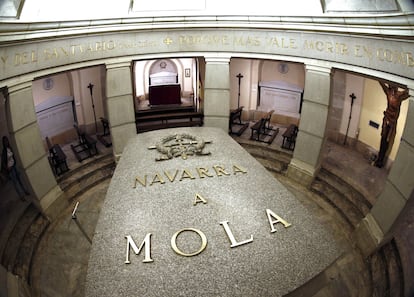The one known as Monument to the Fallen of Pamplona is the largest Francoist exaltation building in Spain in an urban center and the second after the Cuelgamuros Valley. In the regional Community there was no war front, but there was strong repression that resulted in more than 3,000 deaths and forced disappearances. Therefore, one of the recurring questions has been what to do with this building. The debate is complex and has two main options: resignify or tear down. This Wednesday, the majority of the plenary session in the Pamplona City Council has opted for the first. EH Bildu, Geroa Bai (partners in the municipal government) and PSN (in the opposition) have agreed to remove the monument status of the property and convert it into a center for denouncing fascism and for democratic memory that will be called Wonders Lamberto. It is the name of one of the best-known victims of Francoism in Navarra: originally from Larraga, when she was barely 14 years old, she was raped by several Falangists and shot along with her father. This entity will collaborate with the Documentary Center and with the Oroibidea digital archive of the Navarro Institute of Memory, as well as with the Schools with Memory for Peace and Coexistence program of the Government of Navarra.
The PSN spokesperson, Ramón Alzórriz, has highlighted that it is a “historic agreement” that will allow providing a “new narrative to a building that exalts” events “typical of the past and contrary to the values that guarantee democratic coexistence.” Similarly, the coordinator of EH Bildu in Navarra, Miren Zabaleta, has described it as a “historic step” because “it converts a building that for decades has been a problem for victims of Francoism into a historic opportunity.” For his part, Pablo Azcona, from Geroa Bai, has clarified that this is a “minimum agreement on a very complex issue”, although that “agreements like today’s allow us to move forward in trying to close the wounds of Francoism.”
In addition to the change of name, condition and use, the agreement contemplates the demolition of the crypt where the coup generals Emilio Mola and José Sanjurjo were buried until 2016 and which has been used for the celebration of Francoist exaltation masses by the Brotherhood of Volunteer Knights of the Cross. The exterior arches and other architectural elements with Francoist symbols will also disappear. One of the most iconic elements is the large exterior dome, on which an “important specific intervention” is proposed, according to the text of the pact.
In the words of Azcona, the “disappearance of the dome from the urban landscape” is intended, which will allow us to modify “the vision we have of the monument and will take away the primacy that it now has over the entire road axis.” The possibility of making changes to the front and rear façade “linked to the significance of the new center and the renovation of Plaza de la Libertad and its surroundings” is also agreed upon. Inside the building, the internal structure of the dome will be maintained, where the paintings by Ramón Soltz are located, which also praise the fascism that spread throughout Europe in the 20th century. The groups have agreed that these paintings “will be used for critical study through viewings restricted to educational, pedagogical and/or academic purposes.”
In any case, the groups have not proposed a specific architectural project, but rather have set some minimum guidelines. “As soon as possible,” the pact states, they will promote “a competition for projects with concrete bases that include what is established in this agreement.” Different professionals and companies may participate in it and a multidisciplinary jury will be appointed to evaluate the projects. Likewise, they have committed to “carry out a participatory-informative-pedagogical process that includes a unique citizen consultation in Pamplona-Iruña in this regard.” Both the execution of the works and the management of the future interpretation center will be the responsibility of the Pamplona City Council, which is the owner of the building.

On the other hand, among the three groups they also have a majority in the Parliament of Navarra, where they are going to present a proposal to modify the Foral Law 33/2013 of November 26 on Recognition and Moral Reparation of Navarrese citizens murdered and victims of the repression following the military coup of 1936. The objective, they have clarified, is to “provide legal certainty” to this resignification and guarantee that it is irreversible.

